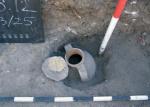Summary (English)
KASTRITSI FORTRESS (Valentin Pletnyov, Igor Lazarenko – lazarenko@mail.bg) The fortress occupied the St. Gianni Cape. It was recorded as Kastritsi on maps and portolans from the 14th century onwards. The explorations of streets, an area to the south of the fortification wall and buildings continued in Sector West. Eleven buildings with two and three rooms were discovered, adjoining and arranged parallel to each other on both sides of the streets. Their walls were preserved up to 1.80 m in height and were 0.70 – 1 m wide, built of roughly-cut stones and ashlars bonded with clay and mud. The buildings had storage rooms with ovens and storage pits for grain. All buildings and streets had two levels and reconstructions dated to the second half of the 14th century, which supports the hypothesis of an earthquake that happened in the middle of the century. The finds comprised pottery, including sgraffito showing images of birds and fishes and monograms that read Demetrios and Palaiologos, a lead trade seal of the end of the 14th century, 258 coins: a gold stater of the Lysimachus Type minted in Kallatis in the 2nd century BC, 26 Roman coins of Hadrian, Septimius Severus, Gordian III, Licinius, Constantius II, Arcadius and Theodosius II, 35 Byzantine coins of Anastasius I Dicorus, Justin I, Justin II, Maurice, Phocas, Heraclius (minted up to AD 614), Isaac I Komnenos, Michael VIII Palaiologos, Andronikos II Palaiologos, Andronikos III Palaiologos, Manuel II Palaiologos and a silver aspra of John II Megas Komnenos of Trebizond, 38 Bulgarian coins of Kings Konstantin Tih (1257 – 1277), Theodor Svetoslav (1300 – 1321/1322), Michael III Shishman (1323 – 1330) with Ivan Stefan, a silver grosso of Michael III Shishman, Ivan Alexander (1331 – 1371) and Ivan Shishman (1371 – 1395), and of the Despot of Dobrudzha Dobrotitsa (1366 – 1385) minted in Drastar and Kaliakra, a tornesello of the Despot of Epirus John II Orsini (1323 – 1335), a hoard of silver ducats of Mircea I of Wallachia, three silver grossi of the Prince of Moldavia Petru II Muşat (1375 – 1391), four Tatar coins of the 13th – 14th centuries including silver dirhams of Nogai Khan, 94 Ottoman copper mangir and silver akçe of Sultans Murad I and Bayezid I and Emir Suleiman (minted up to 1404), and two coins of the Mamluk sultans of Egypt and Syria of the end of the 14th century. The archaeobotanical analysis of pollens, seeds and carbonized fruits discovered in a pot of the 14th century revealed the presence of oak, lime, elm, horn-beam, maple, ash-tree, alder, pine, willow, walnut-tree, plum-tree, hazel-bush, cornel-tree, elder, wormwood, barley, wheat, corn-thistle, poppy, corn-flower, figs and grapes.
- Valentin Pletnyov - Regional Museum of History – Varna
- Igor Lazarenko - Regional Museum of History – Varna






![Download [PDF]](/excavation/skins/fasti/images/results/download_sml.png)
